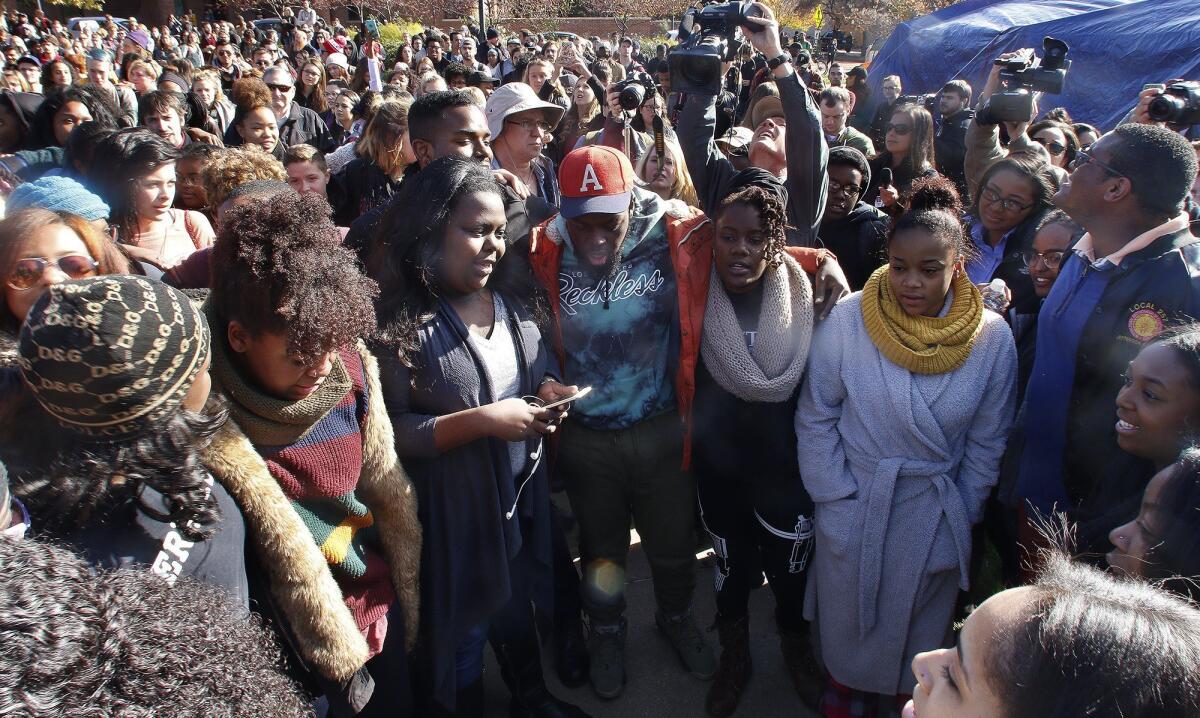Analysis: ‘Free speech’ can be a way to avoid talking about race

Supporters gather after the announcement that University of Missouri System President Tim Wolfe would resign Monday.
- Share via
This week, two different conversations about racial sensitivity on two very different college campuses quickly turned into a national debate on free speech and its limits.
But the breakneck speed of how one subject turned into another reveals more about people’s discomfort revisiting racial history than about 1st Amendment technicalities.
Critics of the protesters at Yale and the University of Missouri say that in fighting for their own rights, they’re restricting those of others. But this interpretation misses centuries of historical context, many students and scholars of color are saying.
Talking about cultural appropriation as a free speech issue rather than one in the context of centuries of oppression misses the point, said Daphne Brooks, a Yale African American studies and theater studies professor.
Take blackface, for example: That was established as a form of entertainment in which white people performed stereotypes of black Americans who were not able to vote, buy property or even play the roles that were mocking them. These characterizations still affect the stereotypes that infiltrate perceptions of black Americans today: as hypersexualized, as animalistic, and intellectually deficient, she said.
Instead of allowing students to don offensive costumes in a vacuum with the protection of free speech, Brooks said, students and faculty should be able to talk about why they’re offensive and how they reinforce racist stereotypes.
“It just seems that free speech in this case is being used as a diversion from the issue that students are trying to bring up a conversation about, and that’s how race affects [the campus],” said Ryan Wilson, a student at Yale.
A similar switch happened at the University of Missouri, when protesters and at least one professor barricaded journalists from the protest space in the University of Missouri’s public quad. (By Tuesday morning, media were allowed in again.)
Missouri succeeded in ousting two administrators. The students celebrated on the quad. But what happened next was more complicated. A video showed that as student photojournalist Tim Tai sought to document the action, protesters surrounded him and pushed him, telling him that he could not photograph them.
Many didn’t understand why protesters would want to bar journalists from their site. On Tuesday, a piece in the Atlantic criticized the protesters and the faculty member who kept media out, accusing the protesters of weaponizing “safe spaces.” Missouri’s journalism school dean said in a statement that he is “proud” of Tai for doing his job, and a professor has apologized, saying that she “regrets the language and strategy” she used, and apologizing for drawing attention away from protesters.
The historical context is key — legally, the 1st Amendment does protect journalists. But journalists do not have a great track record of covering civil unrest fairly. In the 1960s, President Lyndon Johnson commissioned a report to examine media coverage of race riots, which found that “media had sensationalized the disturbances, consistently overplaying violence and giving disproportionate amounts of time to emotional events and ‘militant’ leaders.” The Times had trouble covering the Watts riots. In covering protests in Baltimore earlier this year, many outlets gravitated first toward images of violence and fire.
“We were having some difficult dialogues there, talking about race,” said Jonathan Butler, the graduate student who went on a hunger strike. “That’s a very sensitive space to be in and be vulnerable in. It was necessary to keep that space very healthy, a very open space for dialogue, versus it being a space where people are going to cover a story, exoticize people who are going through pain and struggle.”
At Yale, before emails about Halloween became a national news story, Wilson was relieved to see an email from Yale’s Intercultural Affairs Commission encouraging students to avoid “culturally unaware or insensitive” costumes. A black student in a school where 47% of undergraduates are white, he was used to seeing racist costumes and hearing racist comments.
Like other students, Wilson was shocked when he saw another email from his residential college’s associate master, Erika Christakis. Her email questioned whether faculty had the right to “exercise implied control over college students” and went on to question which level of cultural appropriation is ok. She encouraged students to either ignore or talk about these issues when they arise, and lamented a change in colleges:
“Is there no room anymore for a child or young person to be a little bit obnoxious… a little bit inappropriate or provocative or, yes, offensive?” she wrote. “American universities were once a safe space not only for maturation but also for a certain regressive, or even transgressive, experience; increasingly, it seems, they have become places of censure and prohibition.”
It’s also dangerous when people shine a nostalgic light on academia of the past, Brooks said. Colleges may have been “safe spaces” for regressive behavior because they were much more monochromatic: Students now are more diverse, and that diversity brings up social issues that Ivy students in the past have not had to contend with, Brooks said.
White students accounted for 84.3% of U.S. residents enrolled in postsecondary institutions in fall 1976, compared with 59.3% in 2013.
Yale students of color are angry about the email, and a viral video has made the rounds that shows a student confronting the master of Yale’s Silliman College, whose wife sent the email. Hundreds have signed an open letter that Wilson wrote to the school decrying the email, and more than a thousand students marched on Monday.
Times staff writer Matt Pearce contributed to this report.
Reach Sonali Kohli on Twitter @Sonali_Kohli or by email at [email protected].
More to Read
Sign up for Essential California
The most important California stories and recommendations in your inbox every morning.
You may occasionally receive promotional content from the Los Angeles Times.











